Kentucky, famous for the slogan “Kentucky Unbridled Spirit,” is a good location for wildlife. This “free spirit” exemplifies the hawk, a strong creature of the air.

Hawks are birds of prey of the family Accipitridae. They are native to North America and are distributed across the continent. There are about 270 species of hawk globally – all classified as raptors or birds of prey. Also, they come in various shapes, sizes, and colors, with varying behaviors and environments.
Hawks are powerful birds. Their sharp, curved talons are for catching prey, and their hooked beaks are for tearing it up. Their sense of hearing is superb, and their eyesight ranks among the sharpest in the animal kingdom. Their visual acuity is about eight times that of humans.
Hawks thrive in coastal regions, mountains, grasslands, savannas, forests, prairies, and marshes. Whether you’re driving, hiking in the woods, or relaxing in your backyard, getting a chance to see a hawk is always fun.
This article provides a detailed list of 8 species of hawks in Kentucky, how to identify them, and where to find them.
1. Red-tailed Hawk
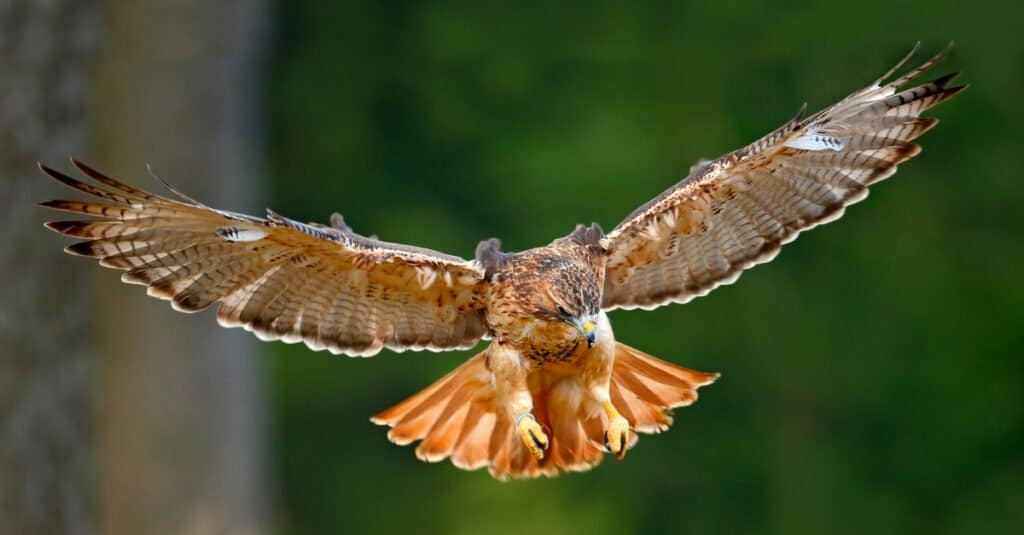
Red-tailed hawks build their nests on top of the tallest buildings, cliff ledges, and tallest trees.
©Ondrej Prosicky/Shutterstock.com
| Red-tailed Hawk | |
|---|---|
| Scientific name | Buteo jamaicensis |
| Weight | 1.5-3.5 lbs (680-1586 g) |
| Height | 18-26 in (45-65 cm) |
| Wingspan | 43-56 in (110-141 cm) |
The red-tailed hawk is probably the most common in North America. You can be sure to see them flying in circles in open fields if you are keen enough. And other times, you can spot them when they sit on a pole to watch for rabbits and other prey.
Their wings are large and rounded like those of a goose. As the name suggests, they have a distinctive short and wide red tail. They also have a brown back and pale underneath with a streaked belly.
Red-tailed hawks have a specialized diet – they prefer mammals. Although they won’t come for your cats or dogs, they feed on moles, ground squirrels, rabbits, small raccoons, mice, and voles. Great-horned owls and bobcats are the primary predators of red-tailed hawks.
Red-tailed hawks build their nests on top of the tallest buildings, cliff ledges, and tallest trees. Females lay between 2-3 whitish, brown-spotted eggs.
Their numbers increase during winter when birds from the far north join the birds that live in your area year-round. Do not expect to see them in your backyard unless you have a large one. But if you want to see these birds, you can go on a long walk or drive.
2. Cooper’s Hawk

Cooper’s hawks only stick to one mate per season.
©Richard G Smith/Shutterstock.com
| Cooper’s Hawk | |
|---|---|
| Scientific name | Accipiter Cooperii |
| Weight | 7.8-14.5 oz (220-410 g) |
| Height | 14-20 in (35-50 cm) |
| Wingspan | 24-39 in (62-99 cm) |
The Cooper’s hawk is a bird of prey that is notable for its small-medium size. They are the size of crows but have the appearance of sharp-shinned hawks. Females are larger than males, and male Cooper’s hawks are pale with orange feathers underneath.
Their diet consists mainly of woodpeckers, quails, plump fowl, chickens, and smaller mammals. They are watchful birds and spend many hours in woodland canopies waiting for prey. Their camouflaged feathers help them blend among the tree branches.
Generally, Cooper’s hawks’ predators comprise eagles and other larger birds of prey. Their only major threat is the widespread use of pesticides, which has destroyed thousands of hawks and other predatory animals.
Cooper’s hawks only stick to one mate per season. Like most hawks, they are solitary. Females lay 2-6 blue or bluish-white eggs.
3. Broad-winged Hawk
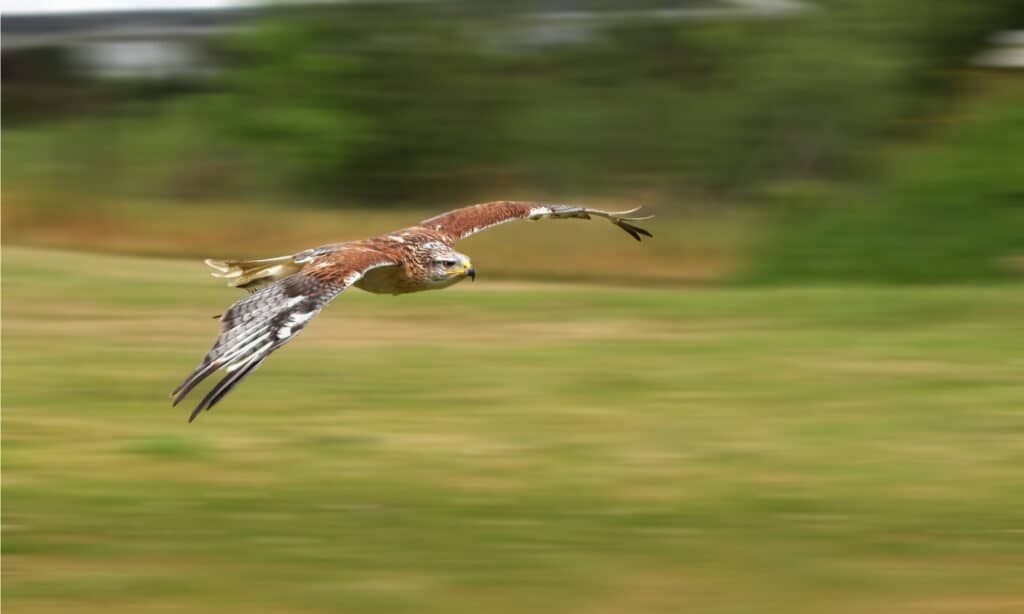
Broad-winged hawks are medium-sized birds of prey with compact, stocky bodies like those of geese and crows.
©pr2is/Shutterstock.com
| Broad-winged Hawk | |
|---|---|
| Scientific name | Buteo platypterus |
| Weight | 9.3-19.8 oz (264-561 g) |
| Height | 13.4-17.3 in (34-44 cm) |
| Wingspan | 31.9-39.4 in (81-100 cm) |
Broad-winged hawks are small hawks with broad wings. They look like red-shouldered hawks but with brown coloration. They can only be found during the breeding season in Kentucky from April to August.
Broad-winged hawks are medium-sized birds of prey with compact, stocky bodies like those of geese and crows. Their diet mainly consists of snakes, lizards, young turtles, frogs, and other small mammals.
Adult broad-winged hawks can sometimes prey on other hawks, eagles, and great horned owls. Their other biggest threats include collisions with vehicles, poisoning, hunting, and habitat destruction.
The females lay between 1-4 whitish eggs with brown spots. The incubation period lasts for about 28-31 days. Both sexes care for their young ones until they can fly and hunt for themselves.
4. Red-shouldered Hawk
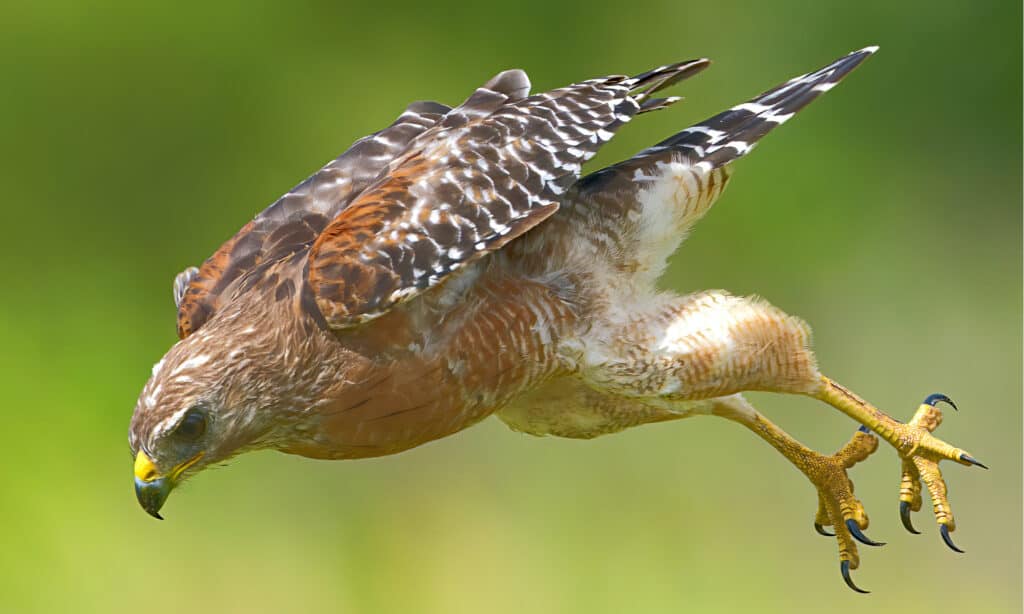
Female red-shouldered hawks lay 2-5 white or bluish eggs.
©Chase D’animulls/Shutterstock.com
| Red-shouldered Hawk | |
|---|---|
| Scientific name | Buteo lineatus |
| Weight | 1-1.7 lbs (486-774 g) |
| Height | 15-24 in (38-61 cm) |
| Wingspan | 35-50 in (90-127 cm) |
Red-shouldered hawks are common in suburban areas, wooden swamps, and deciduous forests. They derive their name from their red-colored wings, with the rest of their bodies decorated with beautiful white and black feathers.
Red-shouldered hawks are less picky in their diet, so they prey on reptiles, rodents, rabbits, crayfish, amphibians, and other small mammals. However, humans, snakes, peregrine falcons, martens, and fishers threaten red-shouldered hawks.
They inhabit wet areas and are known for flying close to the ground. They make their nests in tree crotches.
Female red-shouldered hawks lay 2-5 white or bluish eggs. The incubation period is about 33 days. They are monogamous, and they start breeding once they are two years old.
5. Sharp-shinned Hawk
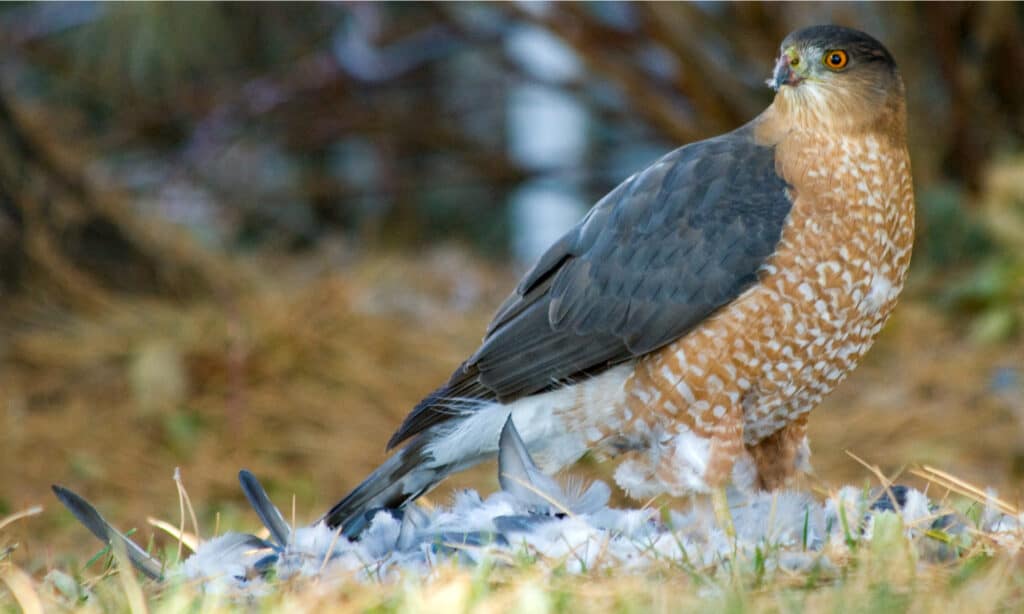
Sharp-shinned hawks are small, long-tailed hawks with rounded wings and square-tipped tails.
©Wyatt W/Shutterstock.com
| Sharp-shinned Hawk | |
|---|---|
| Scientific name | Accipiter striatus |
| Weight | 2.9-7.7 oz (82-219 g) |
| Height | 9.1-15 in (23-37 cm) |
| Wingspan | 17-27 in (42-68 cm) |
Sharp-shinned hawks are small, long-tailed hawks with rounded wings and square-tipped tails. Typically, they weigh less than a pound. Their heads are tiny and hardly visible when they are up in the sky. Female sharp-shinned hawks are bigger than males. They get their name from the nature of their sharply keeled, featherless legs.
Sharp-shinned hawks fly through dense forests to surprise prey with a flight speed of about 60mph. Their flight pattern of the flap-and-glide flight style is unique and outstanding. They feed primarily on small birds like songbirds and quails. They feed on large insects, snakes, frogs, squirrels, and rodents.
Sharp-shinned hawks inhabit the deepest ends of the forests and can only be sighted high in the sky or in open habitats during migration. They build their nests in conifer trees, usually on top of the tallest trees with dense cover. Females lay between 4 and 5 eggs, which take about 30–32 days to hatch.
6. Rough-legged Hawk
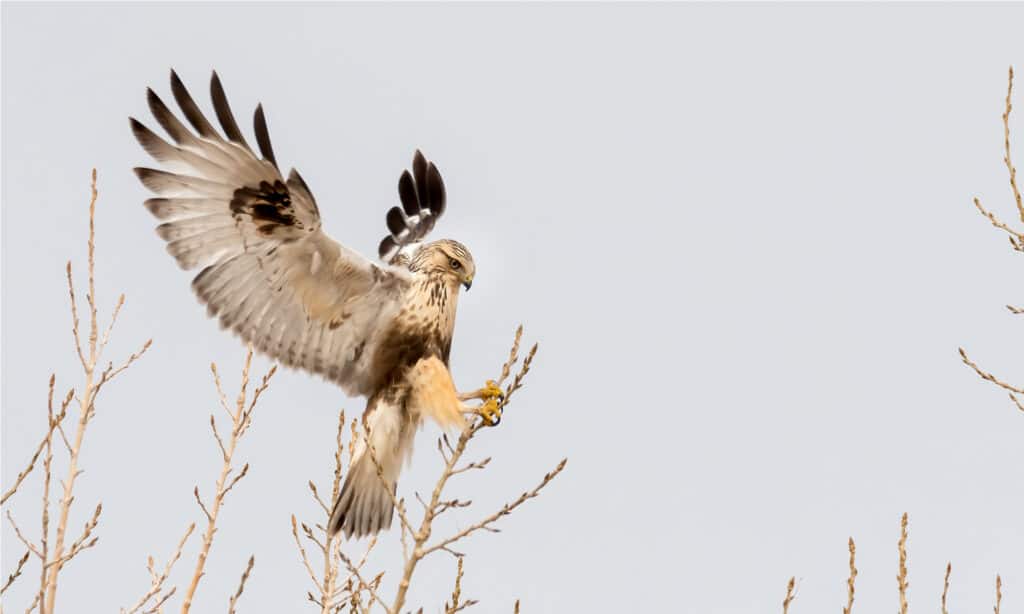
Rough-legged hawks have a diet that consists of rodents, including lemmings and voles.
©Eivor Kuchta/Shutterstock.com
| Rough-legged Hawk | |
|---|---|
| Scientific name | Buteo lagopus |
| Weight | 1.32-3.66 lbs (599-1660 g) |
| Height | 18-24 in (46-60 cm) |
| Wingspan | 52-54 in (132-138 cm) |
Rough-legged hawks are medium to large, with broad but thin wings. Their flight pattern is unique as they fly facing the sky. The ones you see are most likely non-breeding, as these are common in Kentucky.
These hawks have a diet that consists of rodents, including lemmings and voles, and they occasionally feed on birds and amphibians. They inhabit the arctic tundra during the summertime to hunt prey and raise their young.
Females lay 3-5 pale bluish-white eggs incubated for about 31 days.
7. Northern Harrier

Northern harriers live in marshes, prairies, and open fields.
©Harry Collins Photography/Shutterstock.com
| Northern Harrier | |
|---|---|
| Scientific name | Circus cyaneus |
| Weight | 11-27 oz (300-750 g) |
| Height | 21-25 in (53-64 cm) |
| Wingspan | 41-46 in (103-117 cm) |
First things first about northern harriers: they make their nests on the ground. You can easily spot them gliding low over grasslands or marshes. They are slender, medium-sized birds of prey with rounded tails and broad wings. They have striking owl-like faces.
Northern harriers feed on small birds and small mammals. They can also carry bigger prey like ducks and rabbits. However, their diets are affected by changes in seasons and locations. They fly back and forth over the ground while watching and listening for small animals to prey on.
Northern harriers live in marshes, prairies, and open fields. They conceal their nests on the ground and nest in colonies. Females lay 2-4 eggs which hatch in 30-32 days.
8. Ferruginous Hawk
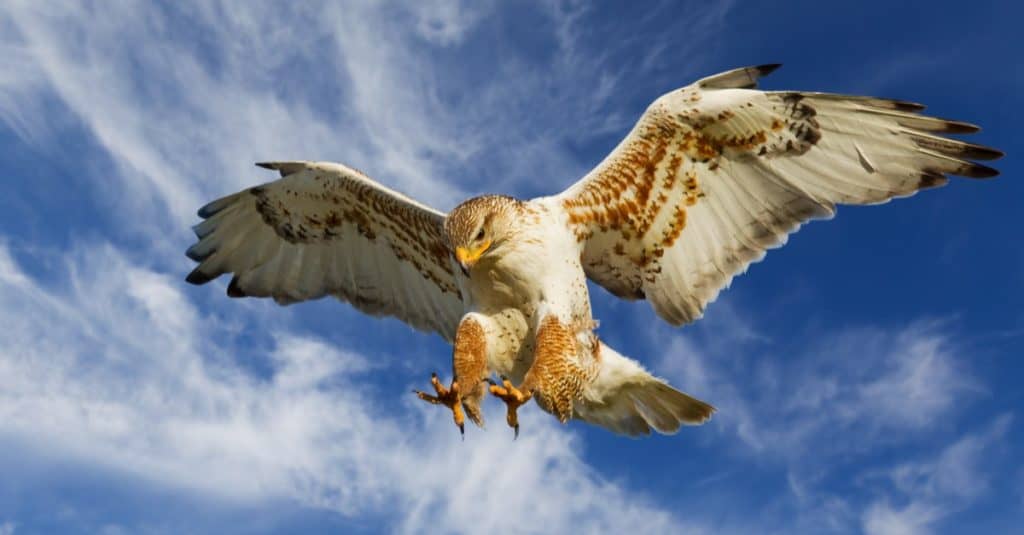
Ferruginous hawks prefer to hunt near open plains such as deserts, sage brushes, and old prairies.
©Stephen Mcsweeny/Shutterstock.com
| Ferruginous Hawk | |
|---|---|
| Scientific name | Bluteo regalis |
| Weight | 32 to 80 oz (907 to 2,268 g) |
| Height | 20 to 27 in (51 to 69 cm) |
| Wingspan | 52-56 in (133-142 cm) |
The bird’s name is derived from the Latin word “ferrum,” meaning iron. This describes the rusted iron color of its feathers. Their unique color pattern, large size, and feathered legs help to identify them.
The ferruginous hawk prefers to hunt near open plains such as deserts, sage brushes, and old prairies to swoop in on its unsuspecting prey. And just in case you want to identify it, observe its legs for feathers, as this is uncommon with other hawks except for the rough-legged hawk.
The ferruginous hawk’s diet consists majorly of mice, squirrels, rabbits, hares, gophers, reptiles, amphibians, small birds, and even insects. When they catch their prey, they either swallow it whole or tear it apart with their beak.
Without major predators and threats, their significant threats include the disturbance to their nesting sites due to agricultural activities and overgrazing. Golden eagles still pose a threat to them in territorial disputes, and bobcats are threats to the juveniles.
The female lays 3-5 eggs, which take about 32 days to hatch. The male hawks also help incubate and brood the hatchlings until they learn how to fly at around 5– 6 weeks.
Summary of 8 Types of Hawks in Kentucky
| Name | Habitat | Prey |
|---|---|---|
| Red-tailed Hawk | Hunt in open fields; build nests on top of the tallest buildings, cliff ledges, and tallest trees. | Moles, ground squirrels, rabbits, small raccoons, mice, and voles. |
| Cooper’s Hawk | Woodland canopies. | Woodpeckers, quails, plump fowl, chickens, and smaller mammals. |
| Broad-winged Hawk | Dense, unbroken deciduous or mixed deciduous/coniferous woodlands; in Kentucky only April to August. | Snakes, lizards, young turtles, frogs, and other small mammals. |
| Red-shouldered Hawk | Suburban areas, wooden swamps, and deciduous forests. | Reptiles, rodents, rabbits, crayfish, amphibians, and other small mammals |
| Sharp-shinned Hawk | Deepest ends of dense forests. | Primarily on small birds, but also large insects, snakes, frogs, squirrels, and rodents. |
| Rough-legged Hawk | Arctic tundra during the summertime. | Rodents; sometimes birds and amphibians. |
| Northern Harrier | Grasslands, marshes, open fields; make their nests on the ground. | Mostly small birds and small mammals. |
| Ferruginous Hawk | Open plains. | Mice, squirrels, rabbits, hares, gophers, reptiles, amphibians, small birds, and even insects. |
The photo featured at the top of this post is © Chase D'animulls/Shutterstock.com
Thank you for reading! Have some feedback for us? Contact the AZ Animals editorial team.






